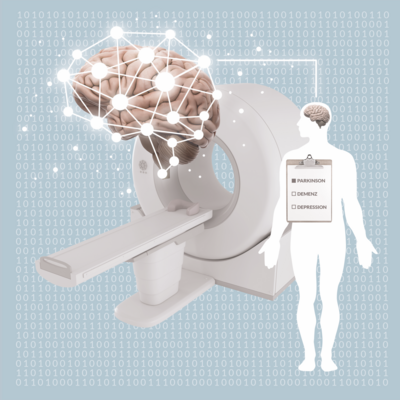Collecting data in flight

The ISTAR is intended to help expand the knowledge of automated and unmanned flying. What is special about DLR's new research aircraft is that it has a digital twin. It collects all the data that the real aircraft generates during its missions.
For almost two years, the Dassault Falcon 2000 – one of the first models in its series – was prepared for its second ‘life’ as a research aircraft in France, and the appropriate equipment was installed. On this January morning, the aircraft is being meticulously polished by numerous diligent workers. A brief rain shower surprises those involved as the aircraft taxies to the hangar where the ceremonial handover will take place. It is given a quick once-over before the big moment, when the key is handed over, opening up a new chapter in DLR aeronautics research.
Prepped for change
Let’s go back to when it all began. In April 2018, DLR signed the purchase contract for ISTAR with Dassault at the ILA Berlin Air Show. At the headquarters of the French aircraft manufacturer in Bordeaux, the twinjet was fitted with sensors, brackets and new cable fittings and underwent other modifications to bring it in line with DLR specifications – all preparations for the installation of the basic measurement system. In future, this central unit in the ISTAR cabin will record key aerodynamic parameters for the aircraft, while also recording signals from the experimental sensors and antennas. It includes a workstation with two positions for flight test engineers, who will control the experiments and monitor the data during the flights. DLR engineers will integrate the basic measurement system in Braunschweig by summer 2020. With it, ISTAR will initially be used as a flight test aircraft investigating aerodynamics, aeroelasticity, structures and propulsion. ISTAR stands for In-flight Systems & Technology Airborne Research.
A digital twin as a faithful companion
In Bordeaux-Mérignac, two pairs of scissors elegantly lie on a red velvet cushion and ribbons have been made taut. Rolf Henke, the DLR Executive Board Member responsible for aeronautics research, and Burkard Wigger, Director of DLR Flight Experiments, stand ready and waiting – beaming with pride and joy. “Our latest research aircraft is developing into an all-rounder for optimised aerodynamics, flight guidance and flight control. ISTAR also enables a major leap forward in the digitalisation of aviation. We intend to create a digital twin for ISTAR, which will accompany it throughout its lifetime,” says Henke. Following the handover, DLR test pilot Jens Heider and a colleague from Dassault taxi the aircraft onto the runway, taking off at around 14:00. This flight marks the completion of the first conversion phase. The coming week, months and years will see the first research flights and new projects in the name of science.
To record every movement during flight, numerous accelerometers are mounted on the outside of the aircraft. These also record how vibrations are damped.
One of these, which will closely accompany the ISTAR during the first three years is the DLR HighFly (High speed inflight validation) project. It will combine initial training for DLR researchers on the new flight test aircraft with the development of the instrumentation. The first measurement flights are scheduled to begin in mid-2020, during which the researchers will record, among other things, mechanical and dynamic properties during specific flight manoeuvres. These will be followed by a Taxi Vibration Test (TVT) and a Ground Vibration Test (GVT) in autumn 2020. The vibration properties of the aircraft will be measured during these investigations. The aircraft will be stationary during the GVT and mobile for the TVT. In order to record every movement, researchers from the DLR Institute of Aeroelasticity in Göttingen will attach numerous accelerometers to the aircraft’s exterior, in addition to the permanently installed acceleration sensors. These will also record how the vibrations excited during the tests are damped.
At the limits of what is possible
From 2021, the HighFly project, which will accompany the development of ISTAR, will enter a second phase. Laser measurement technology, special cameras and microphones will record the turbulent airflow and its acoustics behind a running engine. The Particle Image Velocimetry (PIV) method developed at DLR in Göttingen will be used for this purpose. This technique makes flow patterns visible using pulsed laser light reflected from the smallest light-scattering particles. In 2022, ISTAR’s aerodynamics will be recorded using the latest measurement technology from DLR in Braunschweig. This will take the new research aircraft to the limits of its flight capabilities. The results of these tests will be used to improve computer models for flow simulation and design new aircraft with greater precision while making them lighter and more energy efficient.
The research activities and modifications carried out in the first few years will be important for researchers and pilots to familiarise themselves with the new member of the DLR research aircraft fam-ily. With 12 fixed- and rotary-wing aircraft, it is the largest civilian research fleet in Europe. In 2023, ISTAR will return to Dassault in France, where it will be fitted with an experimental electronic flight control system (fly by wire) and an experimental autopilot system.
This will allow automated pilot assistance systems to be tested, including automatic taxiing and take-off. The system will also be used for tests regarding the integration of unmanned aerial vehicles into controlled airspace. The third and final stage of development will take place at Dassault in the mid-2020s. At this point, ISTAR will be used to test the flight characteristics of new aircraft designs – whether real or virtual, crewed or uncrewed – under real operating conditions. Its digital twin will collect all of the data throughout ISTAR’s entire lifecycle. It will be used to mirror the present operating phase of the real aircraft, as well as to track and manage modifications, maintenance and repairs, alongside operational aspects.
Taking off into the future
At around 16:00 on 31 January 2020, the Sun hangs low in the sky as ISTAR approaches Braunschweig research airport. The international aviation community is following its arrival on social media. The excitement and anticipation generated by this new and versatile research aircraft are almost tangible. Photographers, camera crews and two firefighting vehicles are waiting on the ground to give the aircraft its deserved reception. After touchdown, the newcomer is showered by the two fire engines by way of a welcome. As the Sun sets, ISTAR stands in front of the DLR hangar, its new home. Having witnessed the very first flight, Rolf Henke is now looking to the future: “This is exactly the right aircraft for DLR, for the present time, and for the research that lies ahead.”
Text: Falk Dambowsky
This article was first published in DLRmagazin 164 of the German Aerospace Center (Deutsches Luft- und Raumfahrtzentrum DLR).










